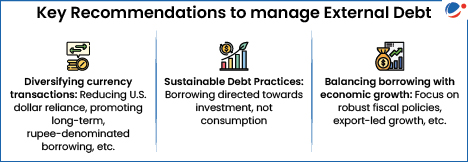As per Finance Ministry’s Quarterly External Debt Report (December 2024), External Debt has risen by 10.7% (from December 2023) mainly due to Valuation Effect.
- Valuation effect occurs due to the appreciation of US dollar vis-à-vis the Indian Rupee.
Other Key Highlights of the Report
- External Debt to GDP ratio: Stood at 19.1% (December, 2024) from 19.0% (September, 2024).
- Composition: US dollar Denominated Debt and Loans constituted the largest component.
- Debt service (Principal repayments plus interest payments): Declined by 0.1% (September - December, 2024).
- Long Term Vs Short Term Debt: Former recorded a marginal increase while the latter observed a marginal decline.
About External Debt
- Meaning: Refers to the money borrowed from sources outside the country, by both the Central Government and Corporations (External Commercial Borrowings).
- Predominantly denominated in other currencies viz., US Dollar, SDR, etc.,
- Sources: Could be foreign commercial banks, international financial institutions like IMF, World Bank, etc., or foreign governments.
Challenges with rising External Debt

- Repayment Burden: Since, it is usually denominated in other currencies, changes in exchange rate affects its repayment burden.
- Rising Inflation: Prolonged inflation further increases the interest rates, slowing down growth, resulting in a higher external debt to GDP ratio.
- Global Scenario: Global threat of stagflation may lower the demand for India’s exports affecting the debt service ratio.



